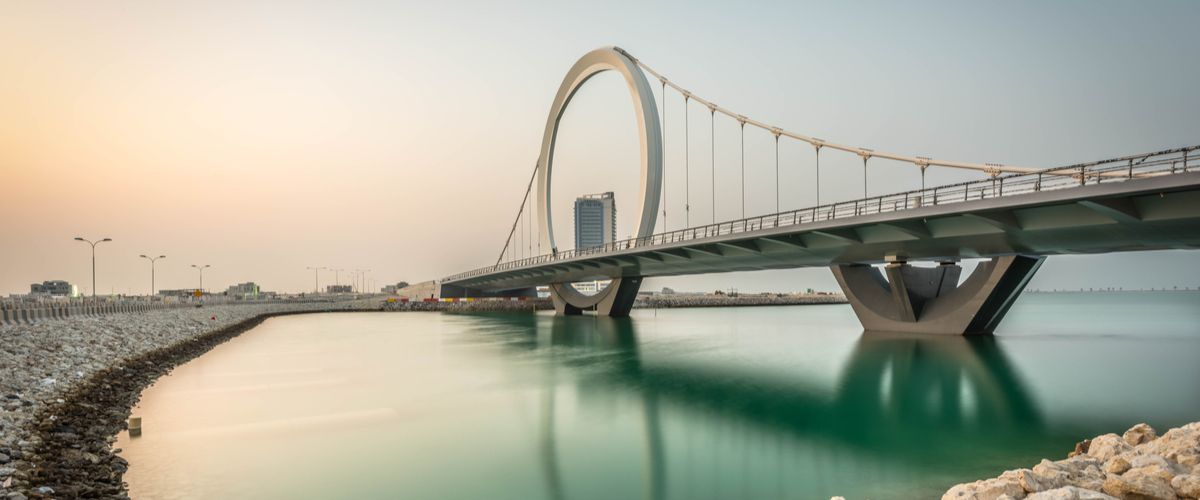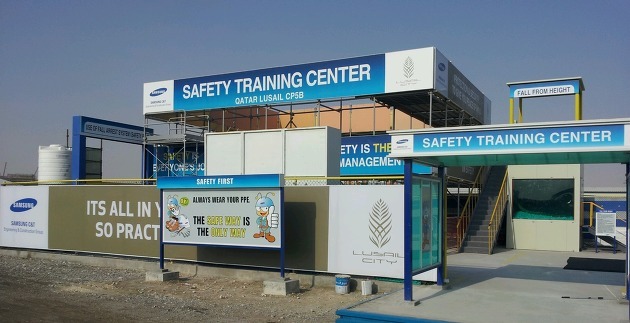Qatar, host of the 2022 FIFA World Cup, is also home to two of the world’s most striking and unique bridges. Let’s learn about the world’s first circular-pylon suspension bridges constructed by Samsung C&T in the new Qatari coastal city of Lusail, located about 23 kilometers north of the capital city Doha.
Bridges shaped like wheels
The new city Lusail has almost ten new bridges, but this article focuses on CP3A Bridges 8 and 9, two suspension bridges built parallel to each other that connect the mainland of Qatar to the manmade Qetaifan Islands.
These are the first two suspension bridges in Qatar, but what makes them unusual is that instead of a straight vertical tower, to which the tops of the suspension cables are anchored, the cables are attached to a pylon that is a shaped like a giant letter O. The two elegant circular towers are connected at their base to the horizontal girders of each bridge’s superstructure. These pylons are 50 meters high (41 above the deck) and are made of steel. Manufactured in Korea, they were moved to Qatar in nine sections and assembled on site without the need for any adjustments to the sections, forming two perfect circles.
There is something unique about the main cable, too. It is the world’s first bridge suspension cable to be made of seven locked-coil cable strands, each 140 millimeters thick. Including fill strips and an outer sheath, the cable is a total of 424 millimeters in width.
Located a little less than a kilometer apart, it is possible to see the circular pylon of one bridge through that of the other, turning their unique design feature into a work of art.
Building safely
Building these bridges, as well as four others, in Qatar presented some special challenges. In a land where daytime temperatures often soar above 40 degrees Celsius, maximum humidity can reach 85 percent, and sandstorms are frequent six months of the year, conditions are not ideal for constructing bridges. Add to that the fact that work with over 4,000 people from 12 different nations speaking different languages, and one can clearly see that safety had to be a top priority.
To ensure good safety practices were carried out, Samsung C&T Engineering & Construction Group established a management plan to match the characteristics of the CP3A project. As well as the environmental conditions and the international workforce, there was a high degree of technical difficulty, all of which had to be taken into consideration. Four key risk areas were identified and safety procedures were put in place to ensure the safe construction of the bridges. The four key areas were working in confined spaces, critical lifting of heavy items, so-called “hot work” (e.g. welding), and working at elevated heights.
To communicate safety-related information to people of all nationalities, multilingual safety bulletin boards were installed, and when tool box talks were held, information was translated into all the languages in use on the worksite.
Furthermore, special safety education was carried out for workers who lacked experience or expertise. Professional training was provided in each type of engineering, especially the four hazardous areas mentioned above, to build up workers’ competence and confidence.
To protect workers’ rights to work in a safe workplace, a “zone stop” system was implemented. When a hazard was found on-site, a sign was displayed throughout that work zone, stopping all activity until the hazard was cleared. Work recommenced in that zone only when the Site Director approved it. In this way, the work was carried out without major accidents, and 6.6 million man-hours without a lost-time accident had been achieved.
Thanks to Samsung C&T’s Engineering Group’s combined capabilities and focus on safety, visitors to Qatar for the 2022 FIFA World Cup are now able to enjoy the sight of two suspension bridges standing parallel to each other, topped with wheel-shaped pylons.











